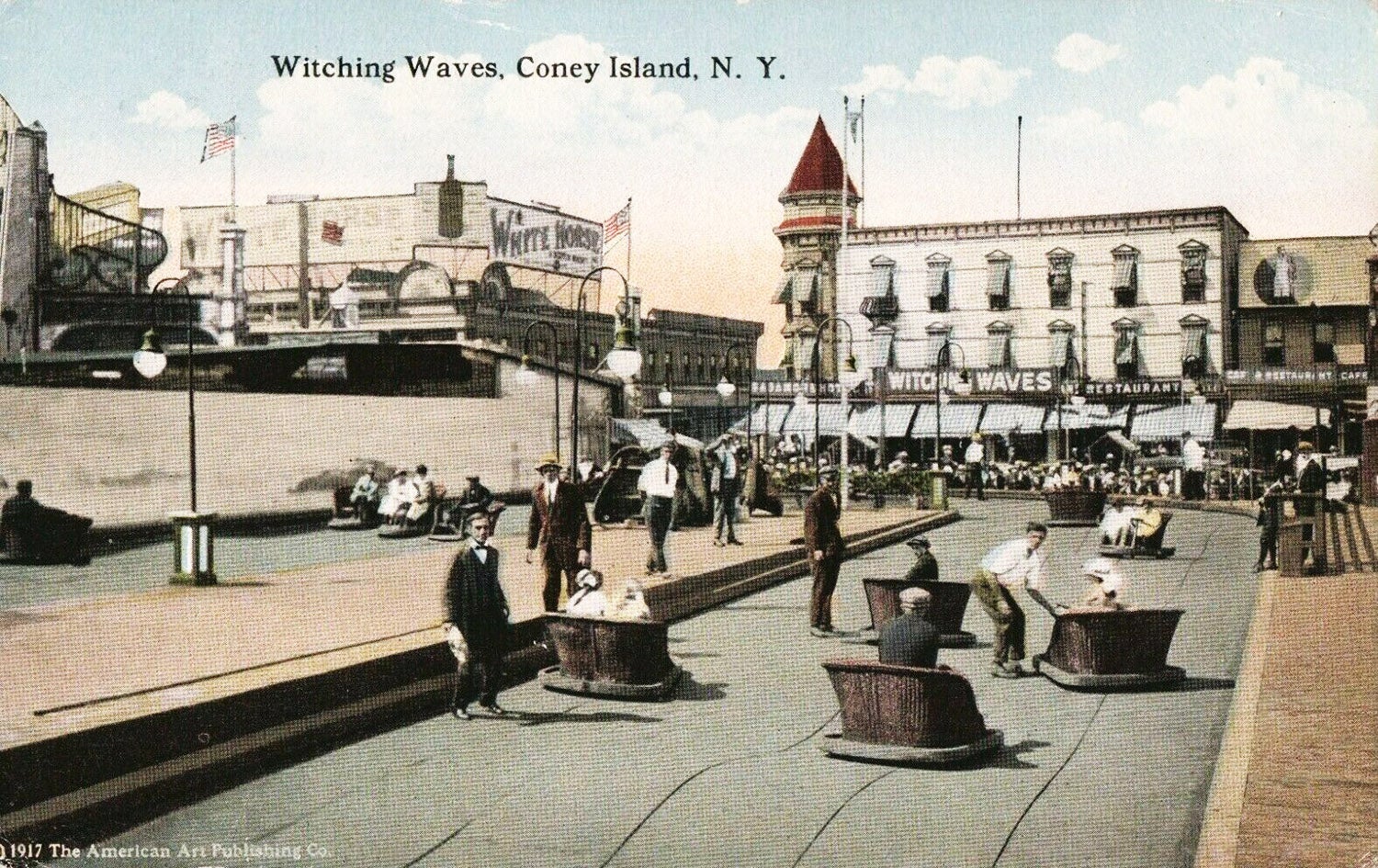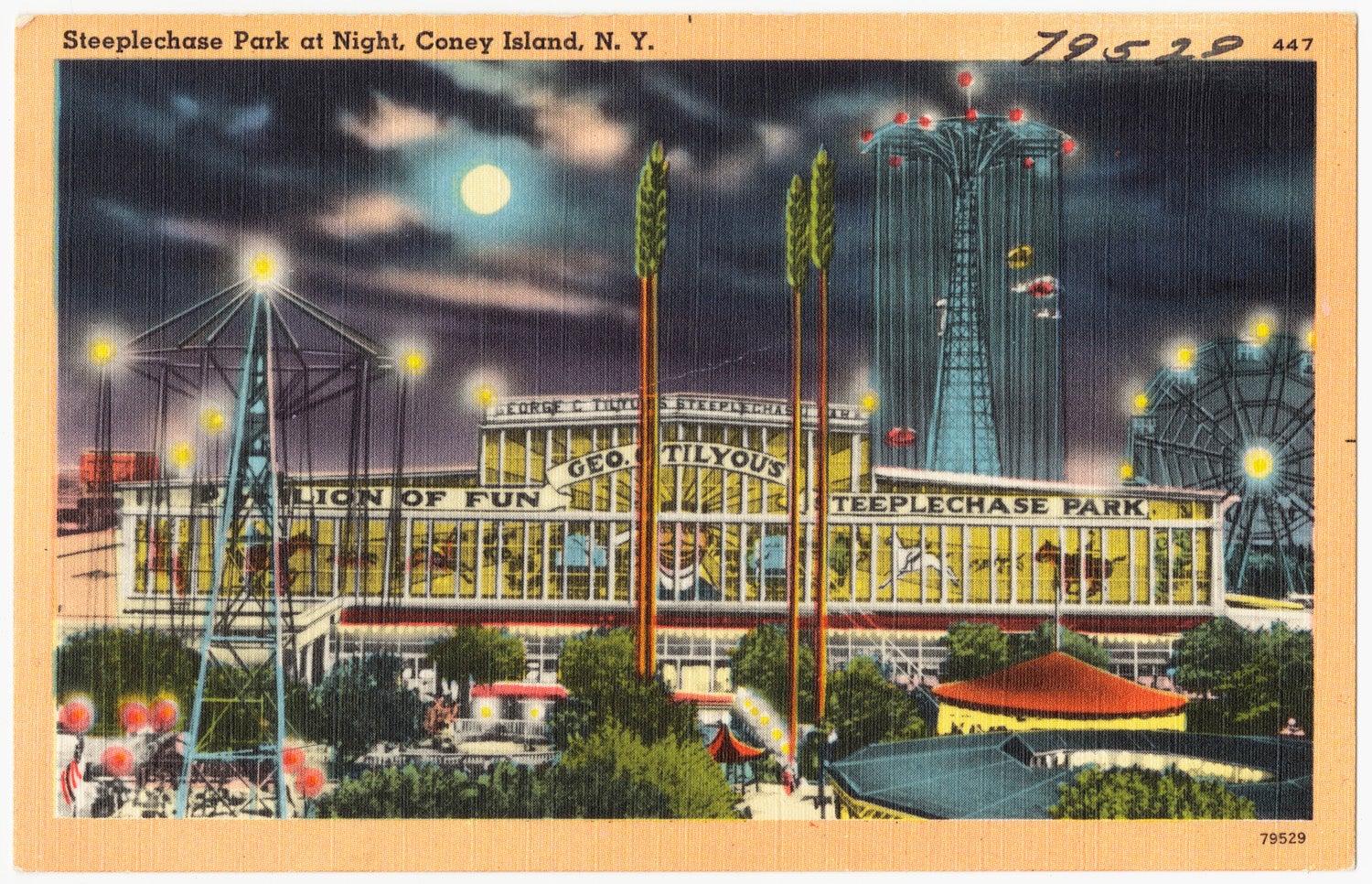Earlier this month, CNN reported that California resident Jeff Reitz had earned a Guinness World Record for taking nearly three thousand daily trips to Disneyland over an eight-year period. And while it may seem like so much repetition runs the risk of making the Matterhorn ride slightly less exciting, deep down, most of us probably acknowledge that visiting a theme park every day does sound like a lot of fun. And, for the fact that we’ve been conditioned to think of amusement parks as bubbles of glee, isolated from the slings and arrows of everyday life, we need look no further than the history of Coney Island and its marquee amusement parks. It was there that packaged thrills became a key American export.
Coney Island, technically part of south Brooklyn, was a draw for New Yorkers well before it became a household name, and through much of the mid-nineteenth century, its appeal lay in the combination of three things a whole lot of people liked: a beach, a hearty disregard for rules, and a clutch of businesses that emphasized pleasure: “scattered restaurants, bath houses and beer saloons, all shacks.” By the early 1870s, however, investors had come to the beach and poured more than twenty million dollars into a range of high-end hotels and amusements, all of which drew middle- and upper-class New Yorkers and their disposable income in droves. “Coney Island,” writes Lucy Gillman, “was New York’s psychological ‘safety-valve.’”

Before long, though, the refined pleasures of eating clams and beer in a palatial hotel, or taking in a carousel, a rollercoaster, or a sideshow, fell by the wayside. The grand pavilions seemed dowdy and increasingly obsolete as prostitution, noise, gambling, and prize fights took over the district in the 1890s. By the turn into the twentieth century, Coney Island was more likely to be called “Sodom by the Sea” than anything else.

Which meant it was ripe for a makeover, and as urbanization, technology, and public transit advanced, early-twentieth-century entrepreneurs hurried to recapture Coney Island as a beachfront paradise for the city. Three major amusement parks sprang up in the early 1900s, in succession and constant competition with each other: the Steeplechase, Luna Park, and Dreamland. The trio offered a cavalcade of rides, each more thrilling than the one before. A 1908 profile in Scientific American described the “Human Toboggan Slide”; the “Tickler”—an inclined plane with various rails down which riders slid and bounced in circular cars like a human Plinko board; and a flume ride called the “Mountain Torrent.” The author raved about Luna Park’s “Witching Waves” ride (invented by the same gentleman who came up with the revolving door), claiming that the waves “are of such size, proportion and speed as to exactly simulate the waves of the sea.”

Steeplechase was the first, and Dreamland tried to be the biggest and flashiest, but it’s perhaps Luna Park that has the most lasting legacy. Studded with electric lights and featuring a grand lagoon, the park was the brainchild of entrepreneurs Frederic Thompson and Elmer S. “Skip” Dundy, who had made a name with “A Trip to the Moon,” a dark ride created for the 1901 Buffalo Pan-American Exposition. Riders on this expedition soared in a sort of winged boat over views of Niagara Falls and into space, where they disembarked onto a papier-mâché lunar landscape to be greeted by costumed “Selenites.” After the exposition, Thompson and Dundy brought the lunar ride at Steeplechase Park, and in 1903, they opened Luna Park, taking their main attraction with them.
Amusement parks proved attractive and profitable, bringing throngs of people and nonstop activity to what only a short time before had been seen as a seedy, has-been of a destination. This was true for a few reasons. As historian Arwen P. Mohun notes, unlike other occasional or itinerant forms of entertainment, such as circuses or festivals, a theme park “was available on nights and weekends, or whenever industrial workers found themselves released from the temporal bonds of wage labour.” Moreover, the parks offered pleasures that were broadly accessible: folks of all classes could take advantage of cheap and readily available mass transit, bring a friend (or a romantic interest), grab a beer and a snack, and spend the evening “clinging to each other on wild rides, watching each other caught literally off balance in fun houses and simply spending time together without direct supervision.” The rides, the common experience, the technology—all of these things, writes Carroll Pursell—“were thrillingly modern.”
Weekly Newsletter
Entrepreneurs liked the concept because they could combine many attractions into a single ticketed site. They could not only control the park universe but play with its form and execution in response to demand. And there was lots of demand. The theme park was a uniquely American model, a soup of innovation and wonder and pleasure, and though Luna Park was neither the first nor the only one of its sort, it would become the emblem of a burgeoning amusement industry. Clones popped up everywhere. For instance, Frederick Ingersoll of Pittsburgh launched a chain of dozens of “Luna Parks.” Even as the Depression dampened the amusements industry at home, manufacturers looked abroad to create new “factories of fun.” Pursell notes that “Luna Park became the namesake and inspiration for dozens of other amusement parks spread across the globe from Japan to Australia, Egypt to Mexico.” Luna Parks appeared globally, “including a chain in Saudi Arabia and a handful of parks in the republics of the former Soviet Union.” Australia had four, the first built in 1912.
The original Luna Park and its Coney Island compatriots were brought down by time, fire, and real estate development, but a new park built on the site of the former Astroland carries on the name. The fundamentals remain mostly the same in an industry worth billions of dollars today, with folks racing to spend a day—or three thousand of them—with a turkey leg and a rollercoaster.
Support JSTOR Daily! Join our new membership program on Patreon today.

Resources
JSTOR is a digital library for scholars, researchers, and students. JSTOR Daily readers can access the original research behind our articles for free on JSTOR.
By: LUCY P. GILLMAN
New York History, Vol. 36, No. 3 (July 1955), pp. 255–290
Cornell University Press
Scientific American, Vol. 99, No. 7 (AUGUST 15, 1908), pp. 108–110
Scientific American, a division of Nature America, Inc.
By: Eyes of the Nation: A Visual History of the United States (Library of Congress)
Library of Congress
By: Arwen P. Mohun
Icon, Vol. 19, Special Issue Playing with Technology: Sports and Leisure (2013), pp. 100–112
International Committee for the History of Technology (ICOHTEC)
By: Carroll Pursell
Icon, Vol. 19, Special Issue Playing with Technology: Sports and Leisure (2013), pp. 75–99
International Committee for the History of Technology (ICOHTEC)
By: Magnum Photos
Magnum Photos